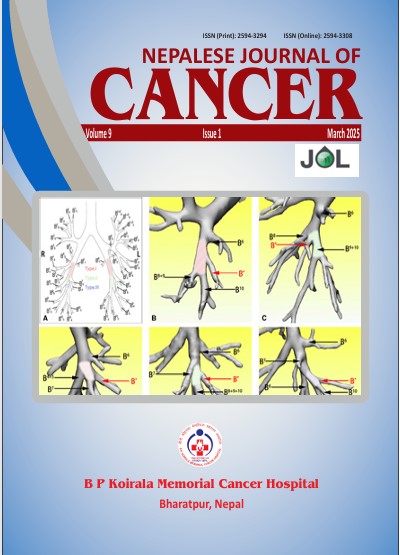Surgical Management of Chest Wall Sarcoma: A Tertiary Cancer Center Experience
DOI:
https://doi.org/10.3126/njc.v9i1.77210Keywords:
Ewing’s sarcoma, chest wall sarcome, chondrosarcomsAbstract
Background: Chest wall sarcoma is an uncommon condition, accounting for less than 5% of all thoracic neoplasms. It can arise frombone, cartilage, or soft tissues, depending on its tissue of origin. The most effective treatment approach is surgical resection with adequate margins. Recent research indicates that chemotherapy, whether administered as an adjuvant or neoadjuvant, may improve both overall survival and disease-free survival. This study focuses on examining common histological types, surgical approaches, post-surgical chemotherapy, reconstruction methods, and overall survival outcomes.
Methods: Our study included patients who had undergone surgical management for chest wall sarcoma at our center since 2005 to 2020. Data from 39 consecutive patients were collected and entered into the Statistical Package for the Social Sciences (SPSS 16) for analysis.
Results: Among 39 patients, the average age was 36 years, with 61% being male. 41% of patient presented delayed with mass size of >10 cm. While 46% underwent surgery alone, 54% received surgery combined with multimodal treatment (radiation and chemotherapy). The median survival was 89 months. Patients with low-grade sarcoma had a significantly better overall survival (Log rank, P<0.01). Although the Ewing’s sarcoma group had the poorest mean survival at 74 months, and the overall median survival could not be determined for this group, no statistically significant difference in overall survival was observed among sarcomas of different tissue origins.
Conclusion: Chest wall sarcomas represent a varied group of tumors. In this study, chondrosarcoma and Ewing’s sarcoma were the most frequent types but exhibited the lowest survival rates, primarily due to high grade tumors at diagnosis. Effective management necessitates a multidisciplinary approach, including aggressive surgical resection to achieve R0 margins. Chest wall reconstruction should aim to restore structural and functional integrity with minimal complications. High-grade tumors are associated with poorer survival, that require multidisciplinary team approach.
Downloads
Downloads
Published
How to Cite
Issue
Section
License
Copyright (c) 2025 Nepalese Journal of Cancer

This work is licensed under a Creative Commons Attribution 4.0 International License.
This license lets others distribute, remix, tweak, and build upon your work, even commercially, as long as NJC and the authors are acknowledged.
Submission of the manuscript means that the authors agree to assign exclusive copyright to NJC. The aim of NJC is to increase the visibility and ease of use of open access scientific and scholarly articles thereby promoting their increased usage and impact.




